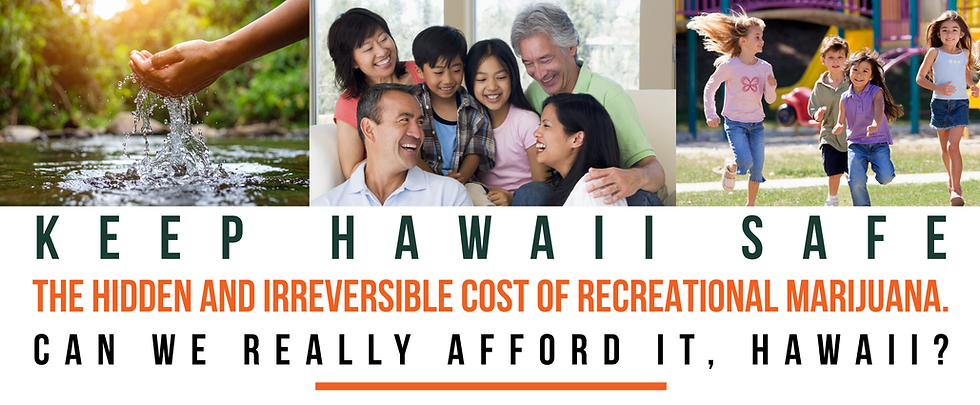The Dangers of Recreational Marijuana in Hawaii
- Dawson Chang

- Dec 29, 2024
- 4 min read
Environmental Impact
“A study reviewing environmental impacts of cannabis cultivation shows that growing the plant in both indoor and outdoor environments is water-intensive and that the high demand for water ultimately leads to water pollution and diversion.”
“The energy and materials required to grow cannabis indoors was studied and quantified the corresponding greenhouse gas emissions. The analysis was performed across the United States and accounted for geographic variations in meteorological and electric grid emission data. Greenhouse gas emissions for legal cannabis ranges from 2,283 – 5,185 kg CO2-equivalent per kilogram of dried flower. Using the EPA calculator, this is equivalent to 583 gallons of gasoline consumed.”
“Outdoor marijuana grows consume an estimated 29.4 million gallons of water per year.” (In CA)

Youth Development and Safety
“Nine out of the top 10 U.S. states by annual marijuana use among youth (ages 12-17) have legalized the drug for recreational use.” Marijuana Legal in 9 Out of 10 States With Highest Youth Use Rate | Just Think Twice
“A systematic review found that recreational marijuana legalization increases the odds of past-month marijuana use by 13% among youth and 22% among young adults.” https://www.jaacap.org/article/S0890-8567(24)00141-2/abstract
Between 2017 and 2021, the percentage of 12th graders who vaped Marijuana in the past year increased from 9.5% to 18.3%.” MONITORING THE FUTURE, 2022A
“A Rand corporation study of 1,887 people age 18-22 who live in Los Angeles, if they live in a neighborhood with a higher number of medical marijuana dispensaries, they use pot more frequently and have a more positive view about the drug.”
Shih RA, Rodriguez A, Parast L et al. Associations Between Young Adult Marijuana Outcomes and Availability of Medical Marijuana Dispensaries and Storefront Signage. Addiction. 2019;114(1):1-22.
“Data from 52 Children’s Hospitals showed an increase of 13.3 fold in marijuana related hospitalizations in children under 6. Half required hospitalization, 15% required ICU care and 4% require mechanical ventilation.”
“The National Poison Data System data for pediatric calls about edible cannabis products in children <6 years noted 7043 exposures between 2017–2021. In 2017, there were 207 reported cases, and in 2021 there were 3054 cases, an increase of 1375.0%. Most exposures (97.7%) occurred in a residential setting. Seventy percent of cases followed to a known outcome were reported to have central nervous system depression. Of all reported cases, 22.7% of patients were admitted to the hospital. There was a significant increase in both ICU and non-ICU admissions.”
Pediatric Edible Cannabis Exposures and Acute Toxicity: 2017–2021 | Pediatrics | American Academy of Pediatrics (aap.org)
“Despite some contentious discussions regarding the addictiveness of marijuana, the evidence clearly indicates that long-term marijuana use can lead to addiction. Indeed, approximately 9% of those who experiment with marijuana will become addicted3 (according to the criteria for dependence in the Diagnostic and Statistical Manual of Mental Disorders, 4th edition [DSM-IV]). The number goes up to about 1 in 6 among those who start using marijuana as teenagers and to 25 to 50% among those who smoke marijuana daily.”
“This study followed 6354 kids from age 15-16 until age 30. The authors concluded that the risk of developing psychosis was increased in individuals who tried cannabis 5 times or move. This increased risk was considered significant and adjusted for other risks such as parental psychosis, substance use, and more.”
“This study of 14,798 adolescents age 12 -17 showed that respiratory symptoms such as wheezing was 2 times higher among those who used cannabis in vaping devises (ENDS – electronic nicotine delivery systems), more than those who used either e-cigarettes or regular cigarettes.”
“In California in 2021, the highest number of marijuana exposure calls to Poison Control Centers were for individuals 5 years of age and under.”
“One of the key findings was that prenatal cannabis exposure was specifically associated with attention problems in early adolescence.”
Health Risks (adults too)
“30% of marijuana users have some form of marijuana use disorder.” National Institute on Drug Abuse, 2019a
“There were 39,092 hospitalizations due to cannabis harms among 32,811 unique individuals between 2003 and 2017, with a 280% increase. Rates of hospitalizations due to cannabis harms were greater in young adults, low-income individuals, and those with mental health comorbidities. Women age 15-24 experienced the largest average annual increase.”
Changes in Rates of Hospitalizations due to Cannabis Harms in Ontario, Canada Before the Legalization of Nonmedical Cannabis: Retrospective Population-level Study Between 2003 and 2017 - PubMed (nih.gov)
“Cannabis has a large epigenetic footprint with major alterations of DNA methylation, a change inheritable to subsequent generations in both mice and man9,19,20,21,22,23,24,25,26.”
Epidemiological overview of multidimensional chromosomal and genome toxicity of cannabis exposure in congenital anomalies and cancer development | Scientific Reports (nature.com)
“A study by the National Bureau of Economic Research (NBER) found a relationship between cannabis legalization and more significant opioid mortality.” (Mathur, N. (2022, February). Marijuana Legalization and Opioid Deaths. NBER Working Paper Series. Marijuana Legalization and Opioid Deaths
“IASIC, the International Academy on the Science and Impact of Cannabis states, “It is our conclusion, based on a review of the scientific evidence, that public health effects of high potency cannabis are harmful. These growing negative impacts further strain health care and addiction treatment resources to an extent that far surpasses taxation revenues." https://iasic1.org/doctors-warn-cannabis-can-cause-serious-health-hazards/



Comments